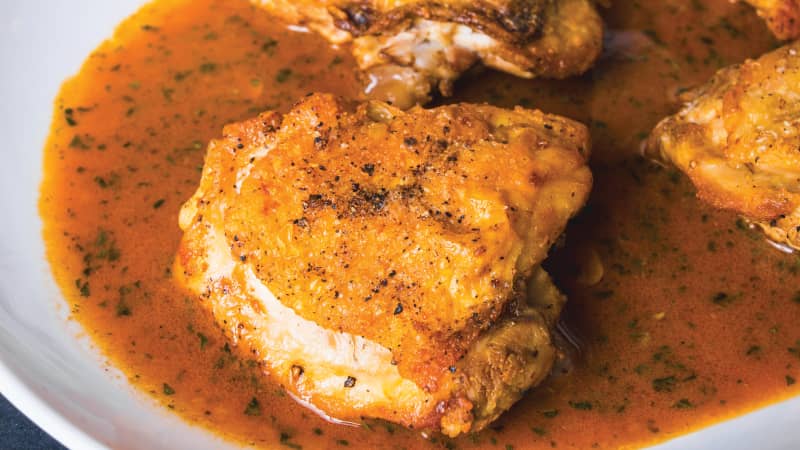When I was a culinary student in France, my most enduring food memories were made in the rustic bouchons of Lyon. That’s where I experienced poulet au vinaigre, a dish that exemplifies the simple and stellar everyday French cooking known as “la cuisine traditionnelle française.”
Poulet au Vinaigre
Published Aug. 5, 2020.

As you might guess, the sauce for poulet au vinaigre features vinegar—the bright, tangy red wine type—but it also includes white wine, chicken broth, fresh tomato, anise-y tarragon, and a bit of heavy cream. White wine is used so as not to impart too much color to the chicken; the red wine vinegar adds tannic intensity and sharpness to the creamy, satisfying sauce.
The dish comes together easily. Bone-in, skin-on chicken pieces (usually both light and dark meat) are first browned in a skillet, and then one of two avenues is taken: The chicken is either pan-roasted before being removed so that the sauce can be built in the empty skillet, or the liquid ingredients are added to the browned chicken and used as a braising medium that is later reduced into a luxurious sauce.
For my version, the braising method was the way to go. It was more convenient than pan roasting and building a separate sauce, and it essentially created a ready-made sauce as the dish simmered. I also opted to use only thighs, as dark meat would turn luscious and tender during braising, not to mention that the rich meat was well suited to the lively sauce.

I started by arranging the thighs skin side down in a hot, oiled skillet. Once the fat was rendered and the skin was deeply browned, I flipped the chicken and browned the other side before removing it. In went some minced shallot and sliced garlic to soften, followed by chicken broth. Most recipes call for a 2:1 ratio of wine to vinegar, so I added 1 cup of the former and 1/2 cup of the latter along with the broth. I nestled the chicken into the liquid skin side up and slid the pan into a 325-degree oven to gently braise. After about 40 minutes, the chicken hit 195 degrees, the temperature at which dark meat is silky and succulent because its collagen has turned to supple gelatin.
I kept the thighs covered on a plate while I reduced the braising liquid, which was now reinforced with chicken juices. When the sauce was nicely thickened, I finished it with fresh tarragon; a peeled, seeded, and diced tomato; and a drizzle of cream.
Make It Your Way
Fresh tarragon is traditional for poulet au vinaigre, but parsley can be substituted. Likewise, dry vermouth can stand in for the wine. Leftovers reheat well, but the recipe can also be halved: Use a 10-inch skillet and keep the cooking times the same.
The chicken was incredibly moist and tender, but the sauce was too sharp. An extra pour of cream mellowed the tanginess, but then the sauce seemed overly rich. To bring things into balance, I dropped the vinegar to 1/3 cup. And finishing the sauce with a couple pats of butter instead of cream enriched it without the dulling effects of excess water and creamy dairy.
The dish now embodied la cuisine traditionnelle française: It was full of flavor, uncomplicated, and unfussy. Well, there was one minor annoyance: having to peel, seed, and dice a tomato. To eliminate that step, I turned to one of my favorite flavor enhancers, tomato paste. Just a tablespoon whisked into the reducing sauce was a fuss-free way to add sweet-tart umami notes without having to mess with a tomato.
As I poured the vibrant, savory sauce around a platter of bronzed, juicy chicken, I smiled, knowing that I now had the means to enjoy one of my favorite French dishes whenever the mood struck.

